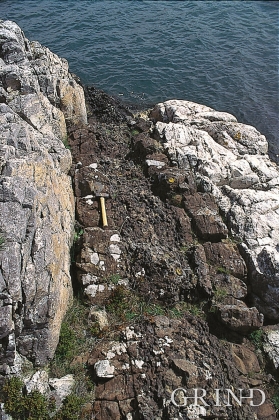Published: 28.07.2015 | Author: Haakon Fossen, Erling Rykkelid
A zone with nuggets from the inner earth. The black vein as it looks from the north side of Busholmen. (Haakon Fossen)
GUEST FROM THE EARTH'S INTERIOR
We know more about the surface of the moon thanwe do about the inside of the earth - the part of the planet that is found below the earth's crust. Occasionally, a fragment of the mantle gets carried to the surfacein flowing rock masses.
At Drøna, in the little sound west of Buspollen, we find just such a fragment in a metre-wide basaltic vein that can be followed 20 metres inland from the shoreline. The vein, from Permian-Triassic times, has a central zone with a rugged surface. This zone is made of a fragment of the mantle. The fragment got concentrated in the middle when the magma flowed up along fractures in the earth's crust. It is calculated that the mantle fragment came from a depth of 60 kilometres, where the temperatures were around 1100 ºC. Don't stamp on this unique outcrop, but stand quietly on it and think that it once was over 1000 ºC and on its way up from the inside of the earth.
The Mantle
The area under the earth's crust and inward to the earth's inner core is called the "mantle". It is made of heavy minerals such as olivine and pyroxene. The temperature is very high (1000–1500 ºC, and high enough that it can make magma. Such magmas can flow upwards through the earth's crust and eventually cool to make magmatic rocks.




